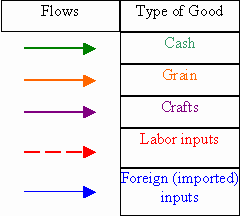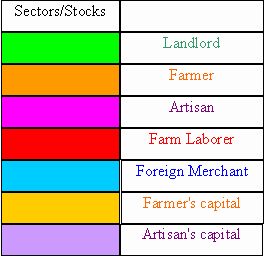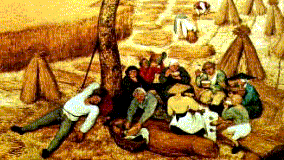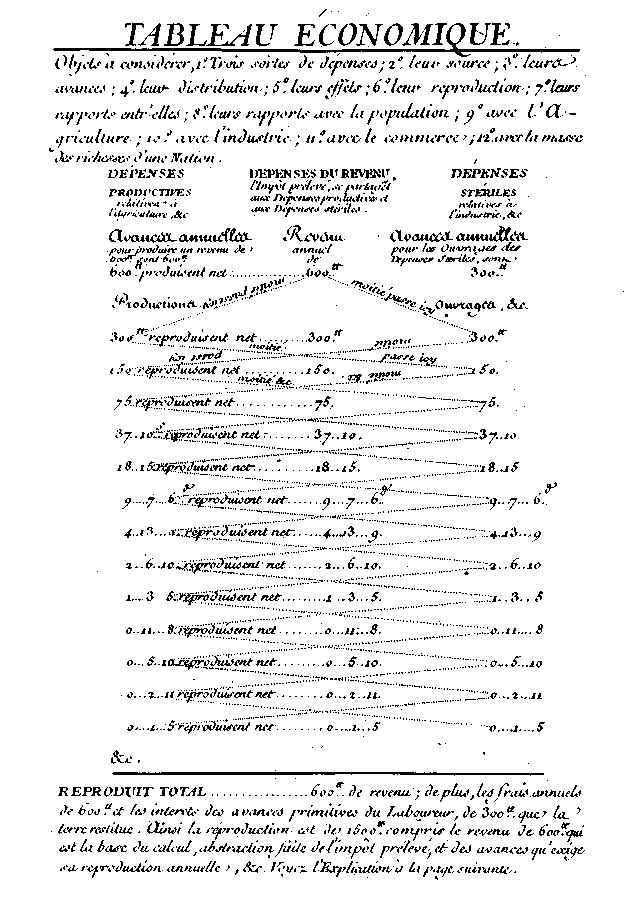|
___________________________________________________________ "You attack Galiani and me because we have no reverence for that ridiculous hieroglyphic which is your holy Gospel. Confucius drew up a table, the Y-King, of sixty-four terms, also connected by lines, to show the evolution of the elements, and your Tableau Oeconomique is justly enough compared to it, but it comes three hundred years too late. Both alike are equally unintelligible. The Tableau is an insult to common sense, to reason, and philosophy, with its columns of figures of reproduction nette terminating always in a zero, striking symbol of the fruit of the researches of any one simple enough to try in vain to understand it." (S.N.H. Linguet, Reponse aux Docteurs modernes, 1771, as quoted in Higgs, 1897) ___________________________________________________________
Contents (1) Nomenclature
In this section, we shall reconstruct the Tableau in a color-coded way that is easier to read and analyze. In this section, we will provide an overview. In the next section, we will consider it in more detail, with a numerical example. (1) Nomenclature Before we begin, let us set aside some preliminary definitions and assumptions which we shall be using in our reconstruction. François Quesnay divided his economy into three sectors or, more accurately, "classes" of people: the proprietary class (landlords), the productive class (people in the agricultural sector) and the sterile class (those in manufacturing and commerce). In our Tableau, we use representative agents from each class and give them more quotidian labels. We will employ a total of five protagonists in our story. Representing the proprietary class is a Landlord, for the productive class we have a Farmer and a Farm Laborer, for the sterile class we have an Artisan and a Foreign Merchant. We also give friendly terms for our goods. At the risk of confusion, we shall use the term "grain" as a catch-all term to denote the products of the agricultural sector. So "grain" includes not only wheat, oats and rye but also beef, leather, flax, hemp, wool, cotton, timber, etc. Natural resources, like coal, peat, iron ore, copper, etc. can also be considered an "agricultural" output. We shall employ the term "crafts" to denote all manufactured goods which use agricultural resources as raw materials. Under this category come things like ropes, leather goods (boots, shoes), woven cloth (woolen, cotton, linen, silk), wooden furniture (chests, chairs, tables), forged iron goods (ploughs, nails, hooks), objects made from precious metals (jewelry, cutlery, candlesticks, etc), etc. We shall use the term "foreign inputs" to denote goods imported from abroad to be used as raw materials in the production of crafts. What we have in mind are things like Venetian glass, Flemish lace, Malian ivory, Sudanese gold, Peruvian silver, Tahitian pearls, etc. which the Artisan will transform into useful objects like clothing and jewelry. For simplicity, we exclude the importation of finished goods. We use the term "cash" to denote, well, cash. To avoid confusing things, we shall think of cash exclusively as gold and silver currency, and omit paper money -- but nothing would really be lost by admitting it. Finally, we have one intangible good or service, "labor input". This merely represents contracted future labor time. We will make the assumption that the Artisan works by himself (one-man workshop), so only the Farmer has the need to buy labor time from the Farm Laborer. This assumption is not necessary, but we will do it for simplicity. Little insight is gained by having artisan-shop laborers as well. Although perhaps it is worthwhile to keep in mind, that in the 18th Century, artisan shop labor came mostly from apprenticing through the guild system, a type of labor that was not freely hired or fired. At this stage in history, freely-contracted labor was primarily a countryside rather than a town phenomenon. (2) Summary of the Tableau Having defined our sectors and goods, let us now turn to the Tableau. It is best perhaps to begin with the big picture, to see where we are heading, before taking it apart piece by piece. For this purpose, we have constructed a version of the Tableau using color-coded nodes and edges (click on it to make it appear in a new window). 
The key is as follows: Edges (colored arrows) indicate flows of goods 
[Solid arrows indicate a flow of a tangible good (cash, grain, etc.). Dashed arrows indicates the flow of an intangible service (i.e. labor inputs).] Nodes (colored boxes) denote the sectors: 
Our diagram reconstructs Quesnay's Tableau using color-coded nodes and edges. Like in the Tableau, the Farmer is on the left side, the Artisan on the right side and the Landlord in the middle. The first thing you should notice about our diagram is that it is not a simple "circular flow" diagram. It is broken down in certain "phases". Each "node", or colored box, is not merely a sector, but a sector at a particular point in time. These nodes will be considered in sequence (top to bottom), so as to be able to decipher which transactions must be completed before other transactions are initiated. This is the critical advantage of conceiving of the Tableau in terms of a monetary circuit. All exchanges between different sectors must be monetized (with one exception we shall note later). Goods don't exchange for goods, they must exchange for money. And we have a fixed amount of money to carry all the goods through. As such, a particular exchange of a dollar for a good must be completed before that dollar can be reused in exchange for another good. That is the difference between the Tableau and other circular flow diagrams. With a monetary circuit, the flows of goods and services cannot be "simultaneous" (as in barter). Rather, because they must be carried by money, these exchanges must occur in sequence, preceding & following one another. This sequential element is not captured in most simple "circular flow" diagrams where a barter economy is implicitly assumed and thus the time aspect omitted. We should note that our picture also permits us to regard each individual node as a particular stock of goods (cash, grain, crafts, etc.) owned by the relevant sector (Farmer, Artisan, etc.) at that point in time. So, each node depicted represents a completely different stock of goods, allowing for the accretions/depletions of stock by the intervening flows. In this general diagram, we have merely depicted the nodes & their flow connections, omitting precise magnitudes. A complete numerical example is easy to incorporate: just insert the magnitudes of stocks & flows at every node & edge. We shall fit Quesnay's own numerical examples to these diagrams later on. We have broken our Tableau down into seven stages which we can summarize simply: (1) The Initial Position: This corresponds to the first line in Quesnay's Tableau. The Farmer has a stock of previously-produced grain, Artisan has a stock of previously-produced crafts and the Landlord has a stock of cash (indeed, all the cash). (2) The Initial Injection: Quesnay's Tableau proceeds with an initial injection of cash by the Landlord to both the Farmer & Artisan to purchase grain & crafts for the Landlord's own consumption. (3) The Zig-Zag Process: This is the most famous part of the Tableau and is actually only represented in summary here in this big picture. In the zig-zag process, the sectors spend money on each other's previously-produced stocks of output (grain & crafts), which can be further subdivided into direct & indirect exchanges: - Zig: Agricultural sector (Farmer & Laborer) buy crafts
(Artisan's output) with their cash income.
- Zag: Manufacturing sector (Artisan & Merchant) buy grain
(Farmer's output) with their cash income Quesnay's original 1759 diagram depicts all the incremental steps of the multiplier-style zig-zag in loving detail. Our diagram only shows the summary flows of the zig-zag. The reasoning behind the zig-zag stage is to acquire the grains & crafts needed to maintain the human parties in the course of the production process. In order to maintain themselves, Artisan, Farmer & Laborer need to consume both grain & crafts; the Merchant needs to export grain (presumably consuming out of resulting commercial profits; this is not detailed). In the direct part of the zig-zag the firms pay each other for goods (Farmer buys crafts; Artisan buys grain). In the indirect part of the zig-zag the firms pay others who then buy goods from the other firm (Farmer pays Laborer who buy crafts; Artisan pays Merchants who buys grain.). In return, the Laborer sells his labor-time, while the Merchant sells foreign inputs. So, the direct part of the zig-zag represents the own-consumption needs (both grains & crafts) of the Farmer & Artisan themselves. The indirect part of the zig-zag represents the consumption needs of Laborers (wages) and the export needs of Merchants. But there are various versions of the indirect part: Wages (indirect zig): Only the Farmer needs to hire Laborers. In Quesnay's original model, there are three versions of the wage payment: (i) Barter Wages: Farmer uses cash received from landlord to buy crafts from Artisan. After deducting a portion for own-consumption, Farmer then pays his Laborer directly with grain & crafts. (this is what is assumed in our next section) (ii) Mixed Wages: Farmer uses the cash received from landlord to buy only the crafts from Artisan he needs for his own-consumption. Farmer pays laborer with grain & remainder of cash. Remainder of cash used by farm laborer to buy crafts from the Artisan on his own account. (this is what is depicted in summary above) (iii) Pure Money Wages: Farmer pays his Laborer completely in cash. Laborer uses some of the cash to buy Farmer's grain & the remainder to buy Artisan's crafts. Farmer uses some of that cash received back from the laborer to buy more crafts for his own consumption. (we discuss this in the 'expanded' zig-zag) But regardless of how wages are paid, the total sums of cash going from the agricultural or 'productive' sector (Farmer & Laborer) to the Artisan & the amount of crafts received by agricultural sector are exactly same in all formulations (i), (ii) & (iii). Exports (indirect zag): Artisan does not hire laborers, but he deals with foreign merchants who import foreign inputs and export grain abroad. There are two versions of this: (i) Foreign Barter: Artisan uses cash received from landlord to buy grain from Farmer. Farmer gives grain directly to Merchant in return for foreign inputs. Merchant exports the grain out of the system.(this is what is assumed in our next section) (ii) Foreign Monetary Exchange: Artisan uses some of the cash received from landlord to buy grain from Farmer & uses remainder of cash to buy foreign inputs from Merchant. Merchant uses cash to buy grain from Farmer & export it out of the system. (this is what is depicted in summary above and in the 'expanded' zig-zag) But, once again, the total sums going from the "manufacturing" or "sterile" sector (Artisan & Merchant) to the Farmer & the amount of grain received by the Artisan & Merchant are exactly the same in both cases (i) & (ii). (4) The Capital Stage We begin the capital stage only after the zig-zag stage is completed. Here, both Artisan & Farmer simultaneously set aside capital for next-year's production of crafts and grain. So there is a strict sequence (zig-zag ® capital stage ® production stage). To produce crafts, the Artisan needs (i) himself, (ii) foreign inputs and (iii) "grain" as direct raw material inputs. The first two were secured in the zig-zag stage (own-consumption & foreign exchange). Only the latter is left. It is acquired in the capital stage by a single, non-reciprocated purchase of grain by the Artisan (a lone zag). We will see that by this step, all the cash in the system is transferred from the sterile sector to the productive sector. Artisan has no more cash in stock. To produce grain, the Farmer needs (i) himself; (ii) labor inputs and (iii) grain for seed & livestock feed (non-wage capital). The first two are secured in the zig-zag stage. Only the latter needs to be acquired in the capital stage. Non-wage capital is acquired from his previously-produced stock of grain (we will see this happens to be the entire remainder of the stock he didn't sell during the zig-zag). (5) The Production Stage All the capital set aside by the Farmer is used up in the production process, yielding grain. All the capital set aside by the Artisan is used up in the production process, yielding crafts. So, the Artisan enters the final stage (post-output) with a stock of new crafts, while the Farmer enters the final stage with a stock of new grain plus all the cash. (6) The Rent Payment This is the all-important closure of the monetary circuit. This happens by a rent payment by the Farmer to the Landlord, transferring all the cash. This happens to be the very step in Quesnay's original Tableau, but we place it as our last (for reasons we'll explain later). (7) The Final Position The final position is identical to the initial position: Farmer has a stock of grain, Artisan has a stock of crafts and the Landlord has the entire stock of cash. And that is all. This, in a nutshell, is Quesnay's Tableau Économique. Let us now go through it in more detail, with a numerical example. Perhaps it is best to keep the big picture open in another window before proceeding.
|
All rights reserved, Gonçalo L. Fonseca


